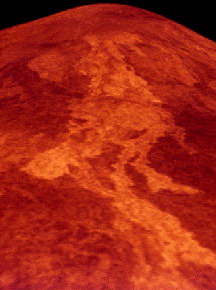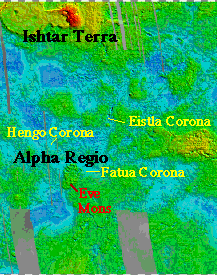This is an image of Venus.
Click on image for full size
NASA/JPL
The Earliest History of Venus
The terrestrial planets formed in two ways, either:
- very warm, separated into layers, with lots of water on the surface, with volcanic activity, as well as continental drift.
- cold and rocky, needing to be warmed from the inside before activity is seen on the surface. The planet never separates into layers, and the planet never forms a core.
With Venus, the first case is probably the most likely.
You might also be interested in:

How did life evolve on Earth? The answer to this question can help us understand our past and prepare for our future. Although evolution provides credible and reliable answers, polls show that many people turn away from science, seeking other explanations with which they are more comfortable.
...more
The Earth-planets formed with the gathering of rocky material and volatiles out of the primitive solar nebula. As they finished forming, the surface continued to be hit by the remnant of planetary material
...more
Alpha Regio is the home of Eve Mons, a volcano.
...more
Aphrodite Terra, the Greek name for the goddess Venus, is about the size of half the continent of Africa, and is to be found along Venus' equator. Aphrodite Terra is different from Ishtar Terra in that,
...more
Beta Regio is an example of a volcanic rise, and is more like an island than a continent. Volcanic rises such as Beta Regio sometimes contain deep troughs. The troughs may be evidence of a surface inmotion.
...more
Ishtar Terra is one of the two main continents of Venus, and is found near the north pole. Ishtar Terra is about the size of the United States. Ishtar Terra contains the four main mountain ranges of Venus.
...more
This image clearly shows a bed where something once flowed. Without proper measurements, scientists can only guess what sort of liquid may have flowed through this channel. On Earth, such channels might
...more
The feature of Venus' geography called a "Corona" is a deep, curving, trench surrounding an elevated plain. Coronae is the name for more than one corona. This is an image of Artemis Corona which is found
...more















